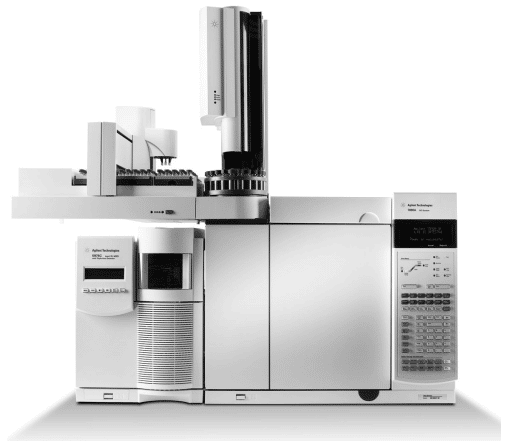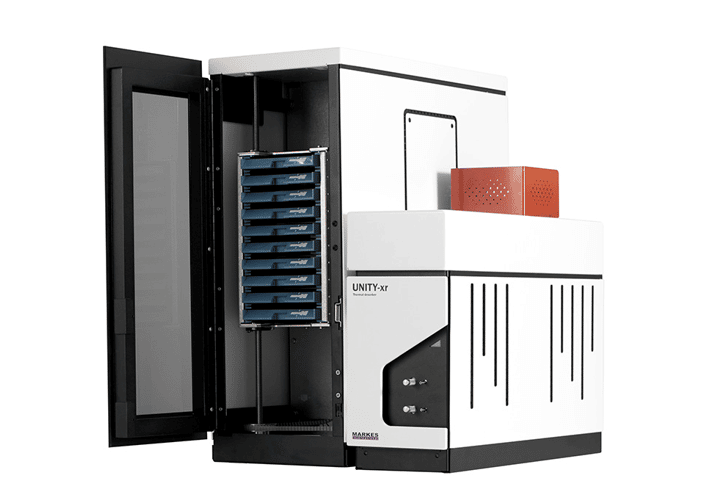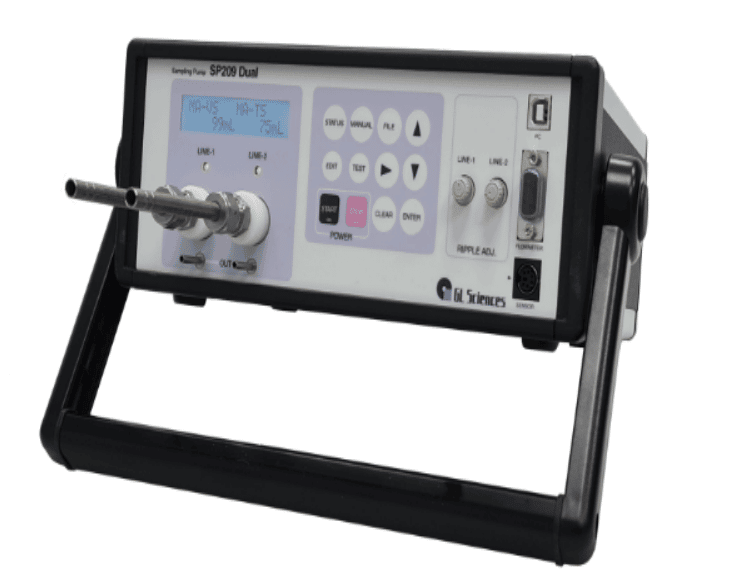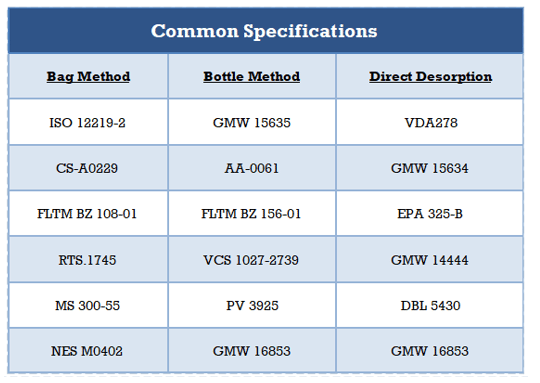What is Interior Emissions Testing?
This refers to the analytical analysis of the volatile organic chemicals (VOC’s) that are present in the materials found in interior components of the vehicle. This is also what makes up the “new car smell.” These chemicals include things like Benzene, Toluene, Styrene, and Formaldehyde. These chemicals remain in the material after production and treatment. VOC’s have a high volatility, meaning that it is easier for them to transition into their vapor form and be released inside the car. The concentration of VOC’s is highest during the first few months of a car’s lifetime, but these chemicals will gradually release over years.

How do we test for VOC’s?
Three main testing principles are used. Gas chromatography/mass spectrometry (GC/MS) is used to quantity a range of volatiles and semi volatiles such as Benzene, Toluene, and Styrene. High performance liquid chromatography (HPLC) is used to quantify the concentration of aldehydes and ketones. UV-VIS photospectroscopy is used to quantify the formaldehyde present in the material. This type of testing can be done at the material, component, and assembly level. These methods provide an objective and quantitative determination of the concentration of VOC’s present.
How is the Sampling Performed?
MGA is capable of performing three main types of testing : bag method, direct desorption, and bottle method. All methods take advantage of the fact that volatile compounds easily turn into vapor and are released from the part/material at elevated temperatures. These temperatures are typically between 40°C and 80°C and the sample is heated for as little as two hours, and as long as 24 hours.
Bag Method : This is the most common method of sampling. This involves using a Tedlar® bag (10 liters for material level tests and up to 2000 liters for component/assembly level tests), placing the sample in the bag, removing any air that remains, and filling it up with inert, ultra-high purity Nitrogen. The bag is then sealed and placed in an environmental chamber at the required test temperature for the desired amount of time. After the time has elapsed, a pump is connected to the valves on the bag, and using a sampling line of conditioned PTFE, two types of samples are drawn from the bag. One of these samples is drawn onto a Tenax® sorbent, where it is later analyzed for a wide range of volatiles using GC/MS. The other type of sorbent that the sample is collected on is a DNPH cartridge. The cartridge is eluted using Acetonitrile and is analyzed via HPLC to determine the concentration of aldehydes and ketones. This method is very common due to its versatility for different sizes and types of samples. This method can test coupons in order to analyze just the material properties, or it can be used to test full assemblies, such as seats or instrument panels.
Direct Desorption : This method is very desirable for determining material characteristics and cannot be used to test components or assemblies. This method skips the sampling process from the bag method and analyzes a very small amount of the material (>100mg) by weighing it and placing it directly in a thermal desorption tube to be analyzed. Two main values are obtained using this method. The first is the VOC concentration (µg/g), which is a sum of a range of compounds with higher volatility (lighter compounds). The second is what is known as the FOG/SVOC (semi volatile compounds).These are compounds that are less volatile and tend to cause the fog that forms on the inside of the vehicle’s windows. This method only uses the GC/MS for analysis, so aldehydes and ketones are not tested for.
Bottle method : This method is what makes up or the fact that direct desorption does not test for aldehydes/ketones for material level tests. These types of compounds are tricky to analyze due to their chemical structure. In order to make it possible for the detector to quantify these compounds, the sample is derivatized using a DNPH and acid solution for HPLC analysis, or ammonium acetate and acetyl acetone for UV-VIS analysis. This method is typically done on samples with a size of 40mm x 100mm. The samples are weighed and a moisture content test is performed to correct for any water in the sample. An aliquot of water (50mL) is placed into a conditioned one liter PET bottle and the sample is hung from the top of the bottle using a hook. The bottle is heated for the desired amount of time, meanwhile the chemicals in the material leach into the water. A volume of this water is derivatized and analyzed. HPLC is used to determine the concentration (µg/g) of multiple different carbonyl compounds, while UV-VIS is only used to determine formaldehyde concentration.
How does the Instrumentation Work?
MGA possesses a number of top-of-the-line analytical instruments that we use for interior emissions analysis. The most crucial aspect of using these instruments, is having a team of trained and educated engineers with years of experience not only running the instruments, but being able to reliably analyze the data as well. Every compound that is reported has an individual calibration curve that is checked using a control solution before every run. This control solution is used to ensure that the concentrations and compound retention time match that of the calibration curve. The instruments are calibrated per the spec, as well as if the control solution is too far off from the calibration curve. Calibration solutions are purchased at a known concentration and diluted to create at least a 5 point calibration curve with at least a 0.995 R2 value. The other important quality check that is done for every test is the use of a blank. The instruments are incredibly sensitive and detect miniscule amounts of chemicals, so contaminants from the air, PET bottles, and especially the Tedlar® bags must be subtracted from the sample data to ensure an accurate result. In order to lower blank concentration values, the bags, bottles, tubes, and sampling lines are all conditioned at a temperature higher than that of the test temperature. This effectively “bakes” off any unwanted volatile compounds.


Tenax® tubes are analyzed using an instrument called a thermal desorber. This heats up the tube to a very high temperature while simultaneously sweeping inert Nitrogen through it. The volatiles are released from the sorbent and are carried to the inlet of the GC/MS. Inside the GC there is a long column that this vapor sample travels through. Inside this column is a stationary phase that allows lighter molecules to move quicker through the column, while heavier molecules take longer. This is how individual components are separated and sorted by retention time. The method of detection uses mass spectrometry, which ionizes the molecule and creates a number of different molecular fragments. The way that a molecule is fragmented is known as the fragmentation pattern and can be compared to a large library of known fragmentation patterns to determine what an unknown peak might be. The mass spec also measures the intensity (number of counts), which creates a series of peaks at certain retention times. This is what is compared to the calibration solution and used to quantitate the data to determine a numerical concentration.
The HPLC analyzes liquid samples and uses solvents such as water and Acetonitrile to pass the liquid sample through the column. This works is in a similar way to the GC, where the components are sorted by retention time and quantified against the peak areas of a known calibration curve. The HPLC uses either a diode array detector (DAD) or multiple wavelength detector (MWD),
The UV-VIS spectrophotometer is used to determine the concentration of formaldehyde in a sample. Using known standards of formaldehyde in water at varying concentrations, the standards undergo a reaction with ammonium acetate and acetyl acetone. This new solution is heated and allowed to cool. Depending on the concentration of formaldehyde, the sample turns a shade of yellow/green with varying intensities. These standard concentrations are plotted and the absorbance detected by the UV-VIS is plotted against the known concentration. Using a wavelength of 420nm (the peak wavelength that is absorbed by the derivatized formaldehyde solution), a sample with no formaldehyde will exhibit no change in color and have an absorbance of zero, and a sample with a higher concentration of formaldehyde will turn a darker shade of green and exhibit a higher absorbance.
Why do we need to test for VOC’s?
It is important to test for these substances as they pose a real health concern to those in the vehicle. Substances like Benzene can pose potential health hazards and are always regulated. The requirements for VOC’s have become more strict through the years with the growing concern of vapor emissions on human health.
Why test at MGA?
MGA Research is one of only a handful of accredited interior emissions testing laboratories in the United States. We pride ourselves in providing timely and accurate results to our customers and we are flexible to specific customer requests. MGA has experienced engineers devoted to VOC testing and can provide free proficiency testing if requested.


